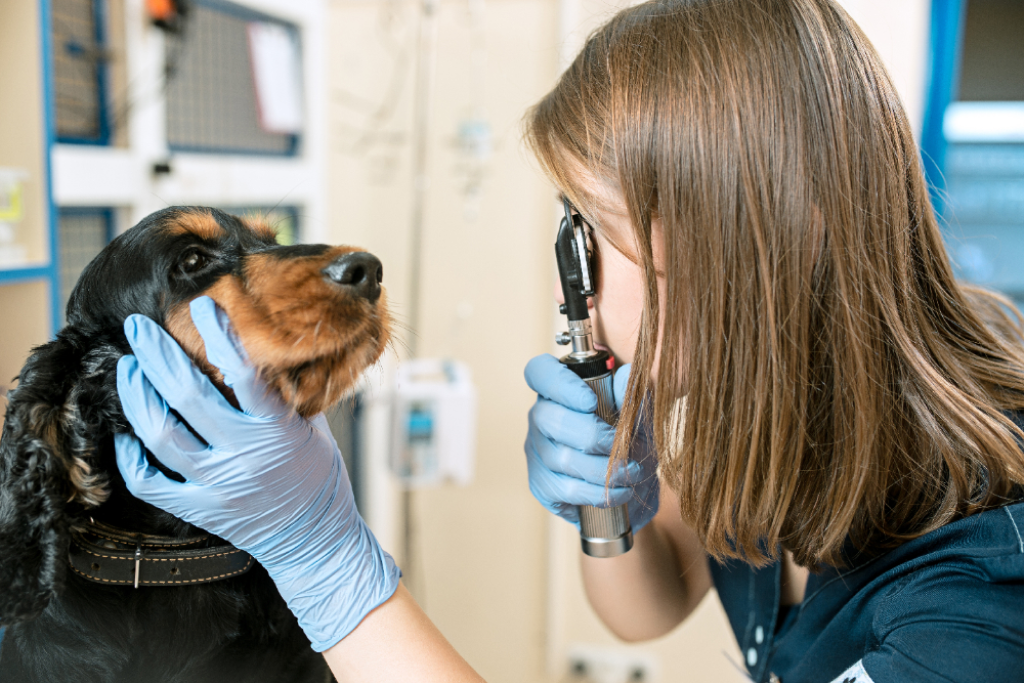What is Pododermatitis in Dogs?
Pododermatitis in Dogs, also known as Canine Pedal Furunculosis, is a term used to describe inflammation that affects the skin of the feet in dogs. The condition often causes swollen, red, itchy feet, which can become painful over time, and in severe cases, can result in dogs becoming lame.
Pododermatitis is a relatively common skin condition in dogs, and is known to present on its own, and as a symptom of other dermatology concerns. It can be caused by a number of factors and, in many cases, more than one cause is common. As such, it’s important to consult your veterinarian as soon as you notice a problem so that they can determine the cause(s), and a suitable treatment plan.
What Breeds are at Risk of Developing Canine Pedal Furunculosis?
Typically, larger breeds and bull breeds are at more risk of developing Canine Pedal Furunculosis, as they tend to have tough short hairs on the skin of their feet that are easily driven into the deeper layers. Such breeds include:
St. Bernards
Great Danes
English Bulldogs
English Bull Terrier
What Causes Pododermatitis in Dogs?
There are a number of things that can cause Pododermatitis in dogs and, in many cases, more than one factor will be responsible. Causes can include:
Parasites:
Parasites such as Demodex can infect the haired skin of the feet, resulting in Pododermatitis. Demodex is present in very low numbers in all dogs but, in some cases, mites can populate in large numbers, causing Pododermatitis.
Foreign Bodies:
Foreign bodies, such as grass seeds, are a very common cause of the condition. They penetrate the skin of the feet and trigger inflammation when they become trapped within the feet.
Allergies:
Allergic diseases in dogs are very common, usually resulting in inflammation which commonly affects the feet.
Hormonal Diseases:
Some hormonal diseases can result in the local skin immune system weakening, compromising the ability to fend off infection.
Deep Infections:
Pododermatitis is very common in dogs with deep infections on the feet, usually as a result of bacteria or fungi.
Conformation:
- Termed conformation pododermatitis typically occurs in larger, heavy-set dogs with excessively splayed feet, which results in weight being barred on hairy parts of the feed, triggering inflammation of the hair follicles.
- Obesity can also play a role in this condition.
- Pododermatitis can be interlinked with orthopaedic disease causing abnormal weight bearing and distribution of weight through the feet.
What are the Symptoms of Canine Pedal Furunculosis?
Common signs of Canine Pedal Furunculosis typically include swollen, red, itchy feet that progress into painful sores if left untreated. However, there are a number of other symptoms to look out for, including:
- Excessive licking and biting at paws
- Inflammation on nails (paronychia)
- Pus from lesions
- Hair loss around the paw area
- Presence of nodules
- Scabs, blisters, and abscesses on the paws
- Hyperpigmentation
- Ulceration on the paw area
- Varying degrees of lameness
How is Canine Pedal Furunculosis Diagnosed?
Diagnosis of Canine Pedal Furunculosis can be achieved with a mixture of a thorough evaluation, the taking of a clinical history, and collecting samples such as hair pluckings and skin scrapings to diagnose Demodex mite infestation. Further to this, a swab sample may be taken to determine if an infection is present.
If signs are pointing towards a foreign body being the cause of the condition, an X-Ray may be performed to establish the severity and of the case, and surgery may be needed to remove the item. Meanwhile, if symptoms indicate Conformational Pododermatitis, diagnosis is usually achieved by thoroughly examining the feet, limbs and assessing the shape of the footpads, x-rays may also be required of other joints.
Your vet needs to accurately determine the cause of the inflammation before being able to prescribe a tailored treatment plan.
How to Treat Pododermatitis in Dogs
Treatment for Pododermatitis in Dogs depends on the cause of the condition. For example, parasitic cases are usually treated with tablets, or dips/rinses for the feet. Meanwhile, deep infections are treated with antibiotics, and surgical procedures are usually required for cases caused by foreign bodies.
However, cases caused by conformation are the hardest to treat as it due to the shape of the feet. In many cases Conformational Pododermatitis can only be managed, not cured, and dogs often require modifications such as protective boots, foot washing and avoidance of rough/uneven terrain. Anti-inflammatories or even physiotherapy may be required to help other orthopaedic conditions if these are diagnosed, and thought to be involved in the problem. In very severe cases, surgery may be an option to fuse the toe webs together, or laser therapy can also be used in some cases.
Small Animal Dermatology at Knutsford Vets Surgery
At Knutsford Vets, we offer a range of veterinary dermatology services and have lots of information and advice in our dermatology hub to help diagnose and treat your dog’s skin conditions.
If you notice any of the signs of Canine Pedal Furunculosis in your dog, get in touch with our friendly team as soon as possible.
We’ll work with you to get to the bottom of what is causing your dog’s inflammation, and recommend a suitable treatment plan to get them back on their feet in no time.
Experience honest, tailored care. Book online today.





